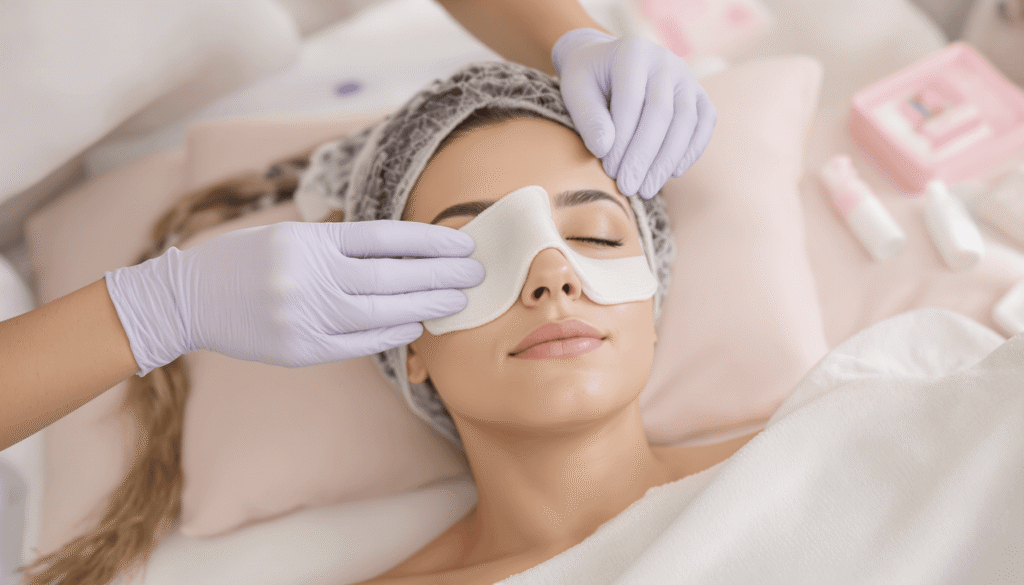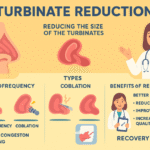Let’s be honest: the first week after rhinoplasty is weird. You’ll catch a glimpse in the mirror and think, who is that person with the tiny ski-slope on their face and purple sunglasses under their eyes? You’re swollen, you’re congested, and you’re trying to sip soup while breathing like a marathoner through your mouth. It’s not glamorous. It is, however, normal.
A quick, true story: a patient told me she tried to whisper to her dog on Day 2 so she wouldn’t “move the nose.” The dog didn’t care, obviously. But she did. That’s the vibe of Week 1—careful, a little dramatic, and very, very human.
This guide walks you through the first seven days—how you’ll likely look and feel, what to do, and when to worry. You won’t find fluff here. Just the stuff I wish everyone knew before the big week.
Day 1: The Heavy Lift
How you’ll look and feel
What you’ll see:
- A firm splint taped across your nose (your new best friend)
- Early swelling around your cheeks and eyes
- Bruising beginning to show (more tomorrow)
- A little oozing or blood-tinged drainage
- Skin that feels tight, especially around the eyes
What you’ll feel:
- Pressure and fullness more than sharp pain
- Total nasal blockage—no air getting through
- Dry mouth and sore throat from mouth breathing and anesthesia
- Fatigue and fogginess (normal after anesthesia)
What’s going on physiologically? Your body is switching on its repair crew. Fluid leaks into tissues (swelling), blood pigments settle under the skin (bruising), and the inside of your nose balloons shut like someone stuffed cotton in there. Annoying, but expected.
What to do today
Pain and comfort:
- Take pain meds on schedule; don’t “tough it out.”
- Expect discomfort to be more “pressure-y” than stabby.
Ice the right way:
- Ice your cheeks, not the nose. Twenty minutes on, forty off, while awake.
- The first 48 hours are when ice actually moves the needle on swelling.
Sleep smart:
- Back only, elevated 30–45 degrees. Pillows or a wedge work great.
- Elevation helps fluid drain; side-sleeping can worsen swelling.
Activity and food:
- Rest, bathroom trips only. No bending, no straining.
- Soft, room-temp foods. Hydrate even if your mouth feels like the Sahara.
Emotional note: Day 1 is the “what did I do?” day. Totally normal. It passes.
Day 2: Peak Drama (and Peak Bruise)
What changes
Looks:
- Bruising is loudest today—dark and theatrical.
- Swelling ramps up. Eyes may puff, especially if bones were refined.
- You look worse than yesterday. That’s the plan.
Symptoms:
- Pain often eases a notch; congestion does not.
- Mouth breathing makes your lips and throat dry. Keep water handy.
Under the hood: the inflammatory wave crests around 48–72 hours. You’re riding it.
What to focus on
Keep icing:
- This is the last day it’s truly impactful. Stay consistent.
Medications:
- Pain meds as prescribed; finish antibiotics if you were given them.
- Use anti-nausea meds if needed.
Hydration:
- Mouth breathing dehydrates you faster than you think. Sip all day.
Mindset: Don’t audit your reflection. You can’t judge anything through all this swelling.
Day 3: The Turn
What improves
You’ll likely notice:
- Pain drops to a dull background hum (many switch to acetaminophen).
- Energy ticks up as anesthesia fully clears.
- Bruising starts to lighten at the edges.
What doesn’t change yet:
- Congestion remains. Swelling can still inch up through Day 3–4.
- The splint stays put. No DIY adjustments.
Physiology check: the acute inflammation is easing, and the real healing work begins.
How to adjust care
- Ice if you like, but don’t obsess—diminishing returns now.
- Short, flat walks are good. Heavy lifting, bending, or straining are not.
- Some surgeons allow gentle saline spray by Day 3–5. Ask first.
- If you sneeze, do it mouth-open. Loud, yes. Necessary, also yes.
Emotionally, Day 3 often brings relief: you’ve turned a corner.
Days 4–5: You Start to Look Human Again
What you’ll notice
Bruising evolves:
- The purple-black shifts to green-yellow. Weirdly satisfying.
- Edges fade first; the center hangs on a bit longer.
Swelling and comfort:
- Puffiness is still there but a touch less aggressive.
- Mornings look worse than evenings—that’s normal fluid behavior.
- Discomfort is minimal; congestion remains the main villain.
Inside story: your body is reabsorbing and metabolizing old blood, while early fluid clears. You’re moving from “alarm response” to “rebuild mode.”
Keep doing the basics
- Splint stays on and dry until your appointment (usually Day 5–7).
- Wash your face gently around the tape; no makeup yet.
- Brush teeth carefully to avoid upper-lip pressure.
- Light desk work and easy walks are fine. No workouts.
- Normal food is okay; avoid ultra-chewy items that pressurize your face.
Social readiness: most people still prefer to lay low. Totally fine.
Days 6–7: Splint-Off Day (aka The Reveal That Isn’t)
What happens at the visit
- External splint comes off quickly; it’s more tape-peel than drama.
- If you had internal splints/packing, removal is odd but brief.
- Your surgeon will do a gentle internal clean.
- You’ll see your nose for the first time—very swollen, very early.
How it usually feels:
- A moment of relief (pressure gone), plus a jolt of “huh.”
- The tip looks puffy; the bridge may look thicker than expected.
- You might think, this can’t be it. It isn’t.
Reality check: one week is not the result. Think 40–50% of the way there—blurry outline, not the final portrait.
After the splint
- Your nose will feel oddly naked and fragile. It is—protect it.
- Keep sleeping elevated. Still no nose blowing (usually 2–3+ weeks).
- If your surgeon okays it, start very gentle saline care.
- No glasses resting on the bridge yet; ask about temporary supports.
Week 1: Normal vs. Concerning
Normal (deep breath—these are expected)
- Big bruises Days 1–4 that fade to yellow-green
- Noticeable swelling all week (and beyond)
- Total congestion with mouth breathing
- Light bleeding/oozing first 24–48 hours
- Lopsided swelling (one side almost always looks different)
- Numbness of the nose and sometimes upper lip
- Tightness/pressure, with occasional zings from healing nerves
- Crummy sleep from the back-only rule
- Mood swings—frustration, relief, repeat
Call your surgeon if you have
- Fever over 101°F (38.3°C)
- Severe, worsening pain not helped by medication
- Heavy bleeding after Day 1
- Foul-smelling, pus-like drainage
- Vision changes of any kind
- One-sided, severe swelling with significant pain
- Spreading redness, heat, or obvious infection signs
Surviving the Week: Practical Stuff That Helps
Sleeping better
- Wedge pillow > pillow tower (less sliding).
- Recliners can be magic this week.
- Build soft “bumper lanes” so you don’t roll.
- Accept mediocre sleep for a few nights—it rebounds.
Handling congestion
- Lip balm, humidifier, nonstop sips of water.
- Throat lozenges for the mouth-breathing sore throat.
- Remind yourself: air through the nose returns in weeks, not days.
Managing how you look
- Stay in during peak bruise days if that eases stress.
- Sunglasses help outside. So does not explaining.
- Limit mirror checks if they crank up anxiety.
- Your job this week is healing, not impressing anyone.
Keeping your head right
- You’re seeing the worst before the best—by design.
- Talk to people who’ve been through it. They’ll tell you it’s temporary.
- Keep perspective with pre-op photos, but don’t spiral.
- Trust the plan you made with your surgeon.
What Week 1 Can’t Tell You
You cannot judge results yet. Swelling, especially in the tip, hides detail. The bridge often appears thicker. All normal.
Healing is just getting started. The next chapters—swelling resolution, tissue remodeling, definition—play out over months. Think 12–18 months for the final story.
It improves faster than you expect. Day 8 beats Day 7. Week 2 beats Week 1. By Week 3, most people feel public-ready. By Week 6, you’re seeing the shape come through. Give it the gift of time.
The Bottom Line
Rhinoplasty recovery week 1 is a mental game wrapped in an inflatable face. You’ll question things at 3 a.m., you’ll baby your nose like it’s made of glass, and you’ll learn creative ways to drink water at a 45-degree angle. And then—quietly—it gets better.
Show up for the basics. Rest, elevate, ice early, don’t bend, don’t blow. Be kind to yourself. Everyone who’s had a nose job walks this same, awkward first mile. You’re walking it too—and you’re already farther along than you think.


